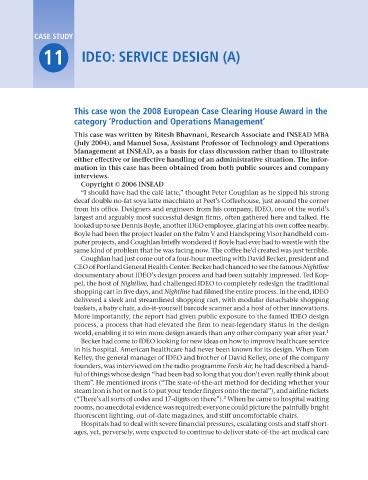Page 447 - Operations Strategy
P. 447
CASE STuDy
11 IDEO: SErvICE DESIgn (A)
This case won the 2008 European Case Clearing House Award in the
category ‘Production and Operations Management’
This case was written by Ritesh Bhavnani, Research Associate and INSEAD MBA
(July 2004), and Manuel Sosa, Assistant Professor of Technology and Operations
Management at INSEAD, as a basis for class discussion rather than to illustrate
either effective or ineffective handling of an administrative situation. The infor-
mation in this case has been obtained from both public sources and company
interviews.
Copyright © 2006 INSEAD
“I should have had the café latte,” thought Peter Coughlan as he sipped his strong
decaf double no-fat soya latte macchiato at Peet’s Coffeehouse, just around the corner
from his office. Designers and engineers from his company, IDEO, one of the world’s
largest and arguably most successful design firms, often gathered here and talked. He
looked up to see Dennis Boyle, another IDEO employee, glaring at his own coffee nearby.
Boyle had been the project leader on the Palm V and Handspring Visor handheld com-
puter projects, and Coughlan briefly wondered if Boyle had ever had to wrestle with the
same kind of problem that he was facing now. The coffee he’d created was just terrible.
Coughlan had just come out of a four-hour meeting with David Becker, president and
CEO of Portland General Health Center. Becker had chanced to see the famous Nightline
documentary about IDEO’s design process and had been suitably impressed. Ted Kop-
pel, the host of Nightline, had challenged IDEO to completely redesign the traditional
shopping cart in five days, and Nightline had filmed the entire process. In the end, IDEO
delivered a sleek and streamlined shopping cart, with modular detachable shopping
baskets, a baby chair, a do-it-yourself barcode scanner and a host of other innovations.
More importantly, the report had given public exposure to the famed IDEO design
process, a process that had elevated the firm to near-legendary status in the design
world, enabling it to win more design awards than any other company year after year. 1
Becker had come to IDEO looking for new ideas on how to improve healthcare service
in his hospital. American healthcare had never been known for its design. When Tom
Kelley, the general manager of IDEO and brother of David Kelley, one of the company
founders, was interviewed on the radio programme Fresh Air, he had described a hand-
ful of things whose design “had been bad so long that you don’t even really think about
them”. He mentioned irons (“The state-of-the-art method for deciding whether your
steam iron is hot or not is to put your tender fingers onto the metal”), and airline tickets
(“There’s all sorts of codes and 17-digits on there”). When he came to hospital waiting
2
rooms, no anecdotal evidence was required; everyone could picture the painfully bright
fluorescent lighting, out-of-date magazines, and stiff uncomfortable chairs.
Hospitals had to deal with severe financial pressures, escalating costs and staff short-
ages, yet, perversely, were expected to continue to deliver state-of-the-art medical care
Z11 Operations Strategy 62492.indd 422 02/03/2017 13:55

